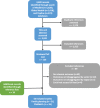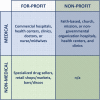Meeting need vs. sharing the market: a systematic review of methods to measure the use of private sector family planning and childbirth services in sub-Saharan Africa
- PMID: 30200964
- PMCID: PMC6131793
- DOI: 10.1186/s12913-018-3514-y
Meeting need vs. sharing the market: a systematic review of methods to measure the use of private sector family planning and childbirth services in sub-Saharan Africa
Abstract
Background: Ensuring universal access to maternal and reproductive health services is critical to the success of global efforts to reduce poverty and inequality. Engaging private providers has been proposed as a strategy for increasing access to healthcare in low- and middle-income countries; however, little consensus exists on how to estimate the extent of private sector use. Using research from sub-Saharan Africa, this study systematically compares and critiques quantitative measures of private sector family planning and childbirth service use and synthesizes evidence on the role of the private sector in the region.
Methods: We conducted a systematic review of the Medline, Global Health, and Popline databases. All studies that estimated use of private sector of family planning or childbirth services in one or more sub-Saharan African countries were included in this review. For each study, we extracted data on the key study outcomes and information on the methods used to estimate private sector use.
Results: Fifty-three papers met our inclusion criteria; 31 provided outcomes on family planning, and 26 provided childbirth service outcomes. We found substantial methodological variation between studies; for instance, while some reported on service use from any private sector source, others distinguished private sector providers either by their profit orientation or position within or outside the formal medical sector. Additionally, studies measured the use of private sector services differently, with some estimating the proportion of need met by the private sector and others examining the sector's share among the market of service users. Overall, the estimates suggest that the private sector makes up a considerable portion (> 20%) of the market for family planning and childbirth care, but its role in meeting women's need for these services is fairly low (< 10%).
Conclusions: Many studies have examined the extent of private sector family planning and childbirth service provision; however, inconsistent methodologies make it difficult to compare results across studies and contexts. Policymakers should consider the implications of both private market share and coverage estimates, and be cautious in interpreting data on the scale of private sector health service provision without a clear understanding of the methodology.
Keywords: Africa; Family planning; Maternal health; Private sector; Systematic review.
Conflict of interest statement
Ethics approval and consent to participate
Not applicable
Consent for publication
Not applicable
Competing interests
The authors declare that they have no competing interests.
Publisher’s Note
Springer Nature remains neutral with regard to jurisdictional claims in published maps and institutional affiliations.
Figures







Similar articles
-
Home treatment for mental health problems: a systematic review.Health Technol Assess. 2001;5(15):1-139. doi: 10.3310/hta5150. Health Technol Assess. 2001. PMID: 11532236
-
Effects of consumers and health providers working in partnership on health services planning, delivery and evaluation.Cochrane Database Syst Rev. 2021 Sep 15;9(9):CD013373. doi: 10.1002/14651858.CD013373.pub2. Cochrane Database Syst Rev. 2021. PMID: 34523117 Free PMC article.
-
Education for contraceptive use by women after childbirth.Cochrane Database Syst Rev. 2002;(3):CD001863. doi: 10.1002/14651858.CD001863. Cochrane Database Syst Rev. 2002. Update in: Cochrane Database Syst Rev. 2010 Jan 20;(1):CD001863. doi: 10.1002/14651858.CD001863.pub2. PMID: 12137636 Updated.
-
Interventions targeted at women to encourage the uptake of cervical screening.Cochrane Database Syst Rev. 2021 Sep 6;9(9):CD002834. doi: 10.1002/14651858.CD002834.pub3. Cochrane Database Syst Rev. 2021. PMID: 34694000 Free PMC article.
-
Cost-effectiveness of using prognostic information to select women with breast cancer for adjuvant systemic therapy.Health Technol Assess. 2006 Sep;10(34):iii-iv, ix-xi, 1-204. doi: 10.3310/hta10340. Health Technol Assess. 2006. PMID: 16959170
Cited by
-
Private sector delivery of quality care for maternal, newborn and child health in low-income and middle-income countries: a mixed-methods systematic review protocol.BMJ Open. 2020 Feb 17;10(2):e033141. doi: 10.1136/bmjopen-2019-033141. BMJ Open. 2020. PMID: 32071179 Free PMC article.
-
Cost of Utilising Maternal Health Services in Low- and Middle-Income Countries: A Systematic Review.Int J Health Policy Manag. 2021 Sep 1;10(9):564-577. doi: 10.34172/ijhpm.2020.104. Int J Health Policy Manag. 2021. PMID: 32610819 Free PMC article.
-
Experiences of private sector quality care amongst mothers, newborns, and children in low- and middle-income countries: a systematic review.BMC Health Serv Res. 2021 Dec 6;21(1):1311. doi: 10.1186/s12913-021-06905-3. BMC Health Serv Res. 2021. PMID: 34872542 Free PMC article.
-
What are the sources of contraceptives for married and unmarried adolescents: Health services or friends? Analysis of 59 low- and middle-income countries.Front Public Health. 2023 Feb 6;11:1100129. doi: 10.3389/fpubh.2023.1100129. eCollection 2023. Front Public Health. 2023. PMID: 36815169 Free PMC article.
-
Private sector quality of care for maternal, new-born, and child health in low-and-middle-income countries: a secondary review.Front Glob Womens Health. 2024 Apr 19;5:1369792. doi: 10.3389/fgwh.2024.1369792. eCollection 2024. Front Glob Womens Health. 2024. PMID: 38707636 Free PMC article.
References
-
- United Nations . Resolution adopted by the general assembly on 25 September 2015. 2015. Transforming our world: the 2030 agenda for sustainable development; pp. 1–35.
-
- Meessen B, Hercot D, Noirhomme M, Ridde V, Tibouti A, Tashobya CK, et al. Removing user fees in the health sector: a review of policy processes in six sub-Saharan African countries. Health Policy Plan. 2011;26(SUPPL. 2):16–29. - PubMed
Publication types
MeSH terms
LinkOut - more resources
Full Text Sources
Other Literature Sources
Medical
Miscellaneous

